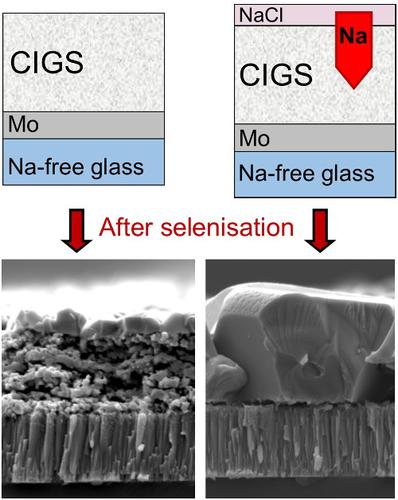当前位置:
X-MOL 学术
›
Prog. Photovoltaics
›
论文详情
Our official English website, www.x-mol.net, welcomes your
feedback! (Note: you will need to create a separate account there.)
Sodium doping of solution‐processed amine‐thiol based CIGS solar cells by thermal evaporation of NaCl
Progress in Photovoltaics ( IF 8.0 ) Pub Date : 2021-03-09 , DOI: 10.1002/pip.3408 Soňa Uličná 1 , Liam M. Welch 1 , Ali Abbas 1 , Mustafa Togay 1 , Vincent Tsai 1 , Tom R. Betts 1 , Andrei V. Malkov 2 , John M. Walls 1 , Jake W. Bowers 1
Progress in Photovoltaics ( IF 8.0 ) Pub Date : 2021-03-09 , DOI: 10.1002/pip.3408 Soňa Uličná 1 , Liam M. Welch 1 , Ali Abbas 1 , Mustafa Togay 1 , Vincent Tsai 1 , Tom R. Betts 1 , Andrei V. Malkov 2 , John M. Walls 1 , Jake W. Bowers 1
Affiliation

|
Poor crystallinity, high degree of porosity and rough surfaces are the main drawbacks of solution‐processed CIGS absorbers resulting in lower power conversion efficiencies when compared to vacuum‐based CIGS solar cells. Therefore, promoting absorber grain growth is key to further improve solution‐based solar cell performance. The effect of alkali elements such as Na in CIGS absorbers is generally recognised to have beneficial effects not only on the absorber opto‐electronic properties but also on the grain growth. In this work, thermal evaporation of a thin layer of NaCl prior to selenisation resulted in absorbers with significantly larger CIGS grains than previously seen with Na diffusing directly from the from soda‐lime glass substrate. NaCl is non‐toxic, abundant and readily available compound that has not been typically used as an evaporation source, but rather as an additive into CIGS precursor solution. The effect of Na on these solution‐processed CIGS devices was primarily observed in the spectacular morphological changes leading to improved carrier collection and minority carrier lifetimes, but less on the absorber doping. Transmission electron microscopy (TEM) revealed voids forming around large CIGS grains upon NaCl addition and these had a negative effect on inter‐grain carrier transport. Nonetheless, the resulting device performance doubled from 5% to 10% with addition of Na using this doping approach; however, a compromise between the optimum grain growth and optimum electronic properties had to be made. This study demonstrates a novel, simple and effective Na‐doping strategy for CIGS absorbers and reveals the current limitations of the Na‐doping in solution‐processed atmospherically deposited cells.
中文翻译:

通过NaCl的热蒸发对溶液处理的基于胺硫醇的CIGS太阳能电池进行钠掺杂
与基于真空的CIGS太阳能电池相比,结晶度差,高孔隙率和粗糙的表面是溶液处理的CIGS吸收剂的主要缺点,导致功率转换效率较低。因此,促进吸收剂晶粒的生长是进一步提高基于溶液的太阳能电池性能的关键。人们普遍认为,CIGS吸收剂中的钠等碱金属元素的作用不仅对吸收剂的光电性能,而且对晶粒长大都有有益的影响。在这项工作中,硒化之前对NaCl薄层进行热蒸发,使吸收剂的CIGS晶粒比以前看到的钠直接从钠钙玻璃衬底扩散而来的CIGS晶粒大得多。氯化钠是无毒的,丰富且容易获得的化合物,通常不用作蒸发源,而是用作CIGS前体溶液的添加剂。Na对这些固溶处理的CIGS器件的影响主要是在形态学上发生了令人瞩目的变化,从而改善了载流子的收集和少数载流子的寿命,但对吸收剂掺杂的影响却很小。透射电子显微镜(TEM)显示,添加氯化钠后在大CIGS晶粒周围形成空隙,这些空隙对晶粒间载流子传输产生负面影响。尽管如此,使用这种掺杂方法添加Na后,最终的器件性能从5%翻了一番,达到了10%。然而,必须在最佳晶粒生长和最佳电子性能之间做出折衷。这项研究证明了一部小说,
更新日期:2021-04-16
中文翻译:

通过NaCl的热蒸发对溶液处理的基于胺硫醇的CIGS太阳能电池进行钠掺杂
与基于真空的CIGS太阳能电池相比,结晶度差,高孔隙率和粗糙的表面是溶液处理的CIGS吸收剂的主要缺点,导致功率转换效率较低。因此,促进吸收剂晶粒的生长是进一步提高基于溶液的太阳能电池性能的关键。人们普遍认为,CIGS吸收剂中的钠等碱金属元素的作用不仅对吸收剂的光电性能,而且对晶粒长大都有有益的影响。在这项工作中,硒化之前对NaCl薄层进行热蒸发,使吸收剂的CIGS晶粒比以前看到的钠直接从钠钙玻璃衬底扩散而来的CIGS晶粒大得多。氯化钠是无毒的,丰富且容易获得的化合物,通常不用作蒸发源,而是用作CIGS前体溶液的添加剂。Na对这些固溶处理的CIGS器件的影响主要是在形态学上发生了令人瞩目的变化,从而改善了载流子的收集和少数载流子的寿命,但对吸收剂掺杂的影响却很小。透射电子显微镜(TEM)显示,添加氯化钠后在大CIGS晶粒周围形成空隙,这些空隙对晶粒间载流子传输产生负面影响。尽管如此,使用这种掺杂方法添加Na后,最终的器件性能从5%翻了一番,达到了10%。然而,必须在最佳晶粒生长和最佳电子性能之间做出折衷。这项研究证明了一部小说,











































 京公网安备 11010802027423号
京公网安备 11010802027423号